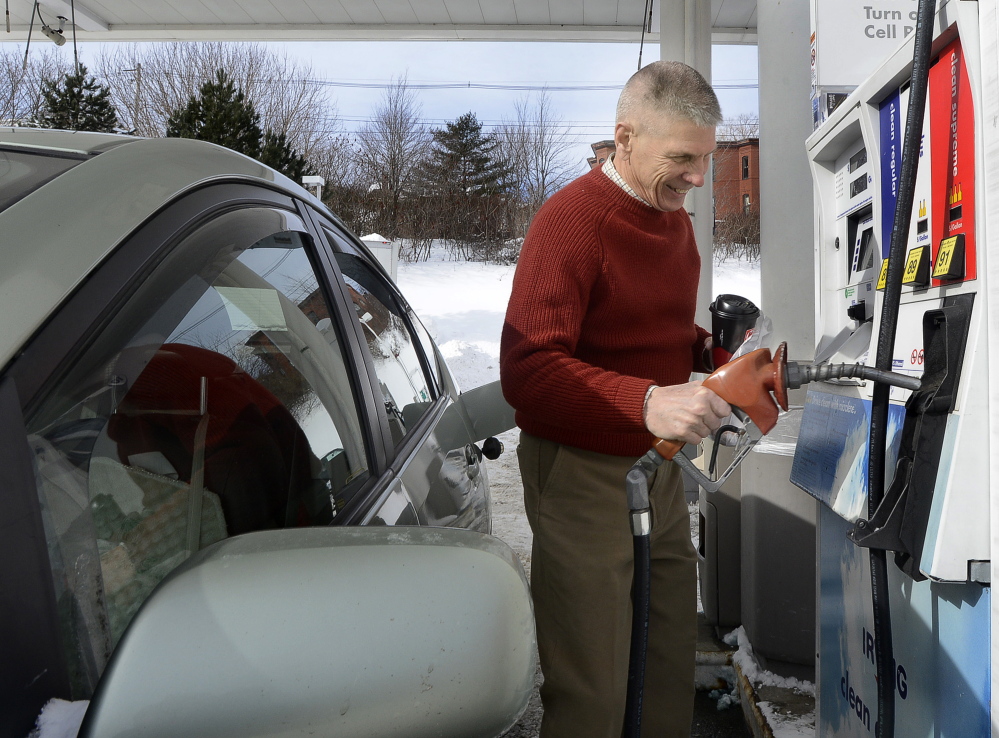Jim Floyd of Standish feels the impact of lower gas prices every week.
“I fill up at half a tank and it used to be $60. Now it’s $40, so $20 a week is very good,” he said. “I never dreamed I would see it this price again.”
Floyd shouldn’t get used to it.
Gas prices, which plummeted over the past three to four months and have settled around $2 a gallon, are expected to start rising again soon. But motorists shouldn’t anticipate a sharp climb, with some analysts predicting prices will top out at $2.50 or even $2.80 when they typically peak in May and June.
“People will notice (prices rising) and fear this is the beginning of the next fuel apocalypse or ‘Mad Max’ movie, but it’s not,” said Tom Kloza, an oil analyst and founder of the Oil Price Information Service.
Prices hit a statewide average of $2.10 per gallon Monday before rising Tuesday to $2.12, according to GasBuddy.com.
But prices have just about bottomed out and will head upward soon, most analysts agree, citing a variety of reasons. Some oil companies have said they’re going to reduce spending on oil exploration this year. There’s been a drop in the number of rigs in the U.S. that are drilling for oil. There’s a strike at some refineries.
But Kloza and Gregg Laskoski, the senior petroleum analyst for GasBuddy, said those factors are less of an influence than the annual pattern in which prices begin rising shortly after the Super Bowl. “Prices go up when our attention returns to baseball, and then they drop when the Cubs get eliminated” from the title chase, Kloza said.
Laskoski said the start of baseball coincides with the onset of the spring and summer driving season, at least in the South and West. That’s also when refineries cut back output as they reformulate their gasoline blends for warmer driving conditions, leading to a short-term crimp in supplies. The result is the low winter prices disappear and the numbers on the pumps start to rise.
“The floor for retail pricing is behind us and we can expect to see prices climb fairly consistently” for the next few months, Laskoski said.
Outside of the Northeast, he said, much of the country has had a relatively mild winter, and that may contribute to a slightly earlier-than-normal start to the peak driving season.
Neither analyst expects a quick return to prices above $3 a gallon, where they’ve been for the past couple of years.
The U.S. Energy Information Administration agrees. It predicts an average price of $2.33 this year, down from $3.36 in 2014.
The forecast is also relatively good for heating oil prices, which have fallen by half over the past year and allowed Mainers to keep more money in their pockets. The EIA is forecasting a 2015 average heating oil price of $2.71 a gallon, a dollar below last year’s average.
Heating oil prices are likely to rise slightly in the next few weeks because of the sharp cold hitting the Northeast and a modest increase in crude oil prices, Kloza said.
But the fundamentals of the oil and gas industry remain poor, at least from the industry’s point of view, Kloza said. Production, particularly in the U.S., remains high, and global demand is low amid weak economic forecasts outside the U.S. He doesn’t see any reason why prices would spike as quickly as they dropped.
Kloza noted that the lowest gas price Tuesday in Maine was $1.99 at the Irving station on Commercial Street in Portland. Although that price will start rising soon, he said, there’s little to suggest it might not fall back to the current level later this year.
The low prices warmed the heart of Sam Davidson, who filled up his Prius – which gets 53 mpg on trips between his offices in Portland and Rockland – for $11.53.
“That’s an all-time low for me,” he said. “I’m delighted.”
Send questions/comments to the editors.




Success. Please wait for the page to reload. If the page does not reload within 5 seconds, please refresh the page.
Enter your email and password to access comments.
Hi, to comment on stories you must . This profile is in addition to your subscription and website login.
Already have a commenting profile? .
Invalid username/password.
Please check your email to confirm and complete your registration.
Only subscribers are eligible to post comments. Please subscribe or login first for digital access. Here’s why.
Use the form below to reset your password. When you've submitted your account email, we will send an email with a reset code.